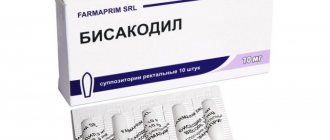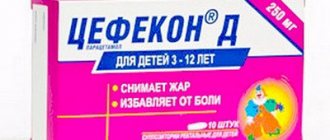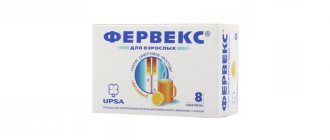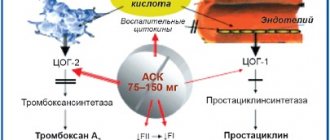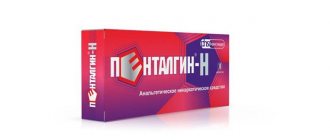Composition of the drug
The effectiveness of the drug is ensured by paracetamol (paraacetylaminophenol), a non-hormonal analgesic with mild antipyretic properties. In suppositories it is included in quantities: 50, 100, 250 and 500 mg. The rest of the candle is solid, highly purified fat, usually of synthetic origin, obtained from plant and artificial components.
News MirTesen
Under normal conditions, fat is a dense, homogeneous white mass, without foreign inclusions or a specific odor. Begins to melt at body temperature.
- Suppositories are formed into a cone-shaped elongated suppository.
- The mass of one candle is 1.25 g.
- The drug is packaged in contoured polyethylene opaque blisters of five pieces, which, in turn, are placed in cardboard packs, which also contain instructions for use.
- The drug is stored at temperatures below 20 °C for no more than three years.
Analogs
According to reviews, in terms of cost, this drug does not need analogues, since its price is already very affordable. In most modern countries of the world, Paracetamol is included in the list of vital medications, so its sale is controlled by the state.
But if the drug is contraindicated or not recommended for any reason, it can be replaced with any other painkiller. To do this, in pharmacies you can find a huge range of medications suitable for each patient.
Today, the number of products containing paracetamol is quite large, so if necessary, replacing the medicine will not be difficult. However, even with structural identity, Paracetamol analogues can differ significantly in the concentration of the active ingredient, additional components and the general way of influencing the child’s body. Typically, doctors mention several analogues:
- “Cefekon D” is the most common drug in pediatrics that has antipyretic properties; the drug is produced in the form of suppositories that can be used to treat infants, the concentration of the active ingredient is 50, 100 and 150 mg per suppository;
- "Viburkol";
- "Perfalgan";
- "Nurofen";
- "Panadol";
- "Genferon";
- "Viferon";
- "Efferalgan."
Pharmacological action, pharmacodynamics and pharmacokinetics
Paracetamol works primarily in the central nervous system (CNS), blocking the enzyme cyclooxygenase, which is responsible for irritating the centers of heat and pain. Thus, the drug lowers body temperature and has a mild analgesic effect.
In peripheral tissues, the compound is blocked by cellular enzymes, so it practically does not work anywhere except the central nervous system.
There is both a positive and a negative point to this:
- on the one hand, paracetamol cannot exhibit its anti-inflammatory properties in other tissues;
- on the other hand, it is not able to have a negative effect on the gastrointestinal mucosa.
Prostaglandins, synthesized under the action of cyclooxygenase (COX), perform a protective function in the gastrointestinal tract. By blocking COX, paracetamol would disrupt the gastrointestinal tract. But since its action does not extend beyond the central nervous system, this does not happen.
Through the rectal mucosa, the compound quickly enters the systemic circulation and then into the liver. There it undergoes a cycle of conversion into inactive metabolites, some of which are toxic to the liver.
The antipyretic and analgesic effect of taking the drug increases during the first hour. After 3–6 hours, the concentration of the compound is halved.
Inactive forms of the compound leave the body in urine. No more than five percent of the drug comes out unchanged.
In what cases are Paracetamol suppositories prescribed to children?
Suppositories are prescribed to relieve two main symptoms: fever and pain.
The indications are:
- Fever due to influenza and respiratory infection.
- Increase in body temperature during the post-vaccination period.
- Fever provoked by “childhood” infections.
- Teething pain and regular toothache.
- Headache.
- Pain caused by injuries or burns.
- Muscle pain from stretching.
- Neuralgia.
Single use is acceptable without a doctor's prescription. The use of the drug for more than three days must be justified by a specialist.
The earliest age for appointment is 3 months. After twelve years, as a rule, suppositories are not used. Children older than a month, but under three, can only be given one-time suppositories when their temperature rises after vaccination.
Instructions for use and dosage
The method of administration of the drug is rectally. The suppository is pulled out from the contour cell and inserted into the rectum. Before giving the medicine, you need to wait for the natural cleansing of the intestines or give an enema.
The effective dose of the compound is calculated based on the age and weight of the child. On average, 1 kg of weight should account for 10 - 12 mg of active substance. The upper threshold of the daily dose is limited to 60 mg per kilogram.
Each subsequent candle can be placed no earlier than four hours later. In general, up to four doses of medication can be taken per day.
50 mg
The medicine in the minimum dosage is used in infants aged from one to three months. One suppository reduces fever or suppresses pain once. Paracetamol should not be given to infants more than once a day.
At the time of treatment, the child's weight must be at least 4 kg. Babies older than three months and weighing more than six kg need a different dosage of the drug.
100 mg
The dosage of 0.1 g is suitable for children aged three months to three years. The child's weight must be no less than 7 and no more than 16 kg. For babies weighing up to 10 kg, one suppository is administered. With a weight of more than 11 kg, 1 - 2 children's suppositories with paracetamol can be administered, depending on the health status of the little patient.
250 mg
Suppositories with a quarter gram of paracetamol are prescribed after three years. The maximum age at which the use of such a medicine is relevant is limited to ten years. The child's weight must exceed 17 kg, but not exceed 30 kg.
To obtain a therapeutic effect, it is enough to administer paracetamol suppositories 250 mg in the amount of one suppository.
500 mg
Starting from the age of ten, when the child’s weight reaches 31 kg, you can switch to oral forms of the medicine. But if the patient, due to the severity of the condition or due to the presence of contraindications from the gastrointestinal tract, is not able to take a tablet or suspension, he can be given an antipyretic drug rectally. The dose for such a patient will be 0.5 g, which equates to two suppositories of 0.25 g each or one containing five hundred mg of the active substance.
Instructions for Paracetamol suppositories for children
Doctors began to mention the toxic effects of the drug even at small dosages only a few years ago, but this fact still remains unproven, and debate on this subject is persistently ongoing.
Many pediatricians recommend antipyretic medication for children from birth, if necessary. Other experts recommend doing without pharmaceuticals. But be that as it may, you can reduce the likelihood of hepatotoxicity by refusing too long treatment and using minimal doses.
Paracetamol suppositories for children with 250 mg of active ingredient are most often prescribed by pediatricians for the treatment of children. This also applies to those children who are hypersensitive to any medications.
Drug interactions
The drug in question is incompatible with drugs that stimulate oxidation processes in the liver parenchyma. Examples of such drugs are: tricyclic antidepressants, ethanol-containing drugs, barbiturates, phenytoin, phenylbutazone, rifampicin, flumecinol. The combined effect of paracetamol with any of these drugs can lead to severe poisoning by oxidation products.
Medicines that are inhibitors of the biotransformation of substances coming from outside, taken simultaneously with paracetamol, can reduce its toxic effect on the liver.
Suppositories for fever for children should not be taken with other paracetamol-containing medications to avoid overdose.
The medicine may enhance the effect of anticoagulants, increasing blood clotting time.
Contraindications, side effects and overdose
The most important contraindication is hypersensitivity. If you are allergic to paracetamol, you need to look for alternative treatments. It is also unacceptable to use antipyretic suppositories for children under one month of age, since there is no reason to believe that such treatment will be safe for them.
Paracetamol is oxidized in the liver to form toxic breakdown products. If the function of an organ is defective, it may not be able to process toxic substances. In case of liver failure, the drug is prescribed with extreme caution. If long-term treatment is necessary, liver function is constantly monitored.
Paraacetylaminophenol blurs the picture of a blood test. It distorts plasma uric acid and sugar levels. In rare cases, with frequent use it causes a drop in the level of hemoglobin, leukocytes and platelets in the blood. After a single administration, reactions in the form of skin itching and rash are possible.
When dosing the drug, you need to remember its hepatotoxic effect.
An overdose first manifests itself as symptoms of poisoning. On the second day, signs of liver damage appear. Poisoning with high doses can lead to necrosis of liver tissue and encephalopathy.
Paracetamol has a specific antidote - acetylcysteine, which must be administered in the first 12 hours after poisoning. The compound helps restore reserves of glutathione, a substance that protects cells from oxidation products. Timely treatment in case of overdose can stop further destruction of the organ.
Paracetamol composition and release form
The drug has several varieties according to its release form. It can be purchased at any pharmacy in tablets, suppositories, syrup or suspension.
Paracetamol tablets
White tablets with a flat surface and a scoring line.
They go on sale in cardboard boxes containing blisters with tablets of 12 pieces.
The active substance is paracetamol.
Excipients: sodium carboxymethyl starch, low molecular weight medical polyvinylpyrrolidone, calcium stearate.
Paracetamol syrup
Paracetamol syrup is a clear, thick liquid that is yellow in color, has a sweetish bitter taste and a characteristic fruity odor. On pharmacy shelves, the drug can be seen in bottles of 50 or 100 milliliters, which are placed in cardboard packs.
The active ingredient of the drug is paracetamol.
The complex of excipients consists of sugar, sorbitol, citric acid, sodium citrate, propylene glycol, ethyl alcohol, riboflavin, sodium benzoate, aromatic additives and water.
Paracetamol suppositories
The drug is produced in the form of suppositories for rectal use for children. It is a torpedo-shaped candle, white or off-white with a cream (yellowish) tint.
It goes on sale in cardboard packs that contain two blister packs, each containing 5 candles.
The active ingredient is paracetamol, which is supplemented by a fat base as an excipient to complete the suppository to the required weight (1.25 grams).
Paracetamol suspension
Paracetamol suspension is a viscous liquid that is pink in color and has a fruity odor.
It goes on sale in a cardboard package that contains a dark glass bottle of the drug with a volume of 100 milliliters.
The active substance of the drug is paracetamol. It is complemented by a complex of excipients consisting of sorbitol, distilled glycerin, carbomer, methylparaben, propylparaben, citric acid, sodium citrate, sodium saccharinate, food flavoring, red sour coloring 2C, purified water. Unlike syrup, Paracetamol suspension does not contain alcohol.


